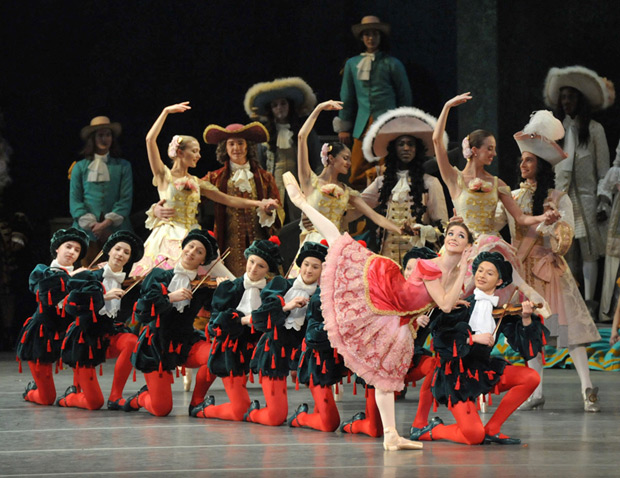
© John Grigaitis. (Click image for larger version)
American Ballet Theatre
The Sleeping Beauty
★★★✰✰
Paris, Opera de Bastille
2 September 2016
www.abt.org
www.operadeparis.fr
I was eager to see American Ballet Theatre’s Sleeping Beauty, mounted by Alexei Ratmansky last year, because of the enthusiastic reviews it has received in the United States. The Paris premiere, however, met with muted acclaim: perhaps Ratmansky’s research into Petipa’s original intentions was not to the taste of audiences accustomed to Rudolf Nureyev’s grandiose production for the Paris Opera Ballet. Dance critics, however, revelled in the nuances of academic technique that Ratmansky and ABT have restored.
I was initially disconcerted by what seemed a compromise between an attempted reconstruction of an Imperial Russian ballet and an acknowledgement of contemporary expectations. So, no high extensions (except for arabesques penchées) but fish dives and balances that were later additions – and some interpolated choreography that looks very like Frederick Ashton’s for the Royal Ballet.

© Gene Schiavone. (Click image for larger version)
The designs are also a compromise. Richard Hudson researched Léon Bakst’s sets and costumes for Diaghilev’s London production in 1921 and adapted them substantially for the demands of modern-day lighting and touring conditions – and no doubt finance as well. The 1921 production bankrupted Diaghilev. Hudson’s colour palette is unappealing and the copious use of glitter makes costumes resemble those for a revue rather than a royal court. Wigs are hideous, especially for the men, and so badly fitted that the Royal Ballet’s wig-makers would weep if they saw them.
How different is ABT’s production from the Sleeping Beauties of the Royal Ballet and English National Ballet (both of which are similar)? Ratmansky decoded the Stepanov notation from the 1890s, now housed in a Harvard library, in order to retrieve Petipa’s choreography as nearly as possible. He and his wife also studied the early-Cecchetti style of dancing, before ballet technique became increasingly acrobatic. The result, carefully imparted to ABT’s dancers, looks Ashtonian in its speedy footwork, supple use of the torso and lavish épaulement. It’s quite close to how the Royal Ballet used to dance de Valois’s productions of The Sleeping Beauty, based on Nikolai Sergeyev’s notes and memory of the Imperial Ballet stagings he knew.

© Doug Gifford. (Click image for larger version)
The pacing of Ratmansky’s production allows more time to unfold the story in mime and in mustering large numbers of dancers. In the Prologue, much more is made of the gifts the fairy godmothers present to the infant Aurora. The fairies’ entourages include very active pages as well as cavaliers in boots and hats. The men’s bounding sextet, not in the notated choreography, is much like the Royal Ballet’s. Catalabutte, the master of ceremonies, becomes a tiresomely comic character well deserving of having his hair pulled out by Carabosse.
The fairies’ variations are familiar, though danced in a less virtuoso style than is usual nowadays. Legs are kept low, retirés and passés at calf height, as is the foot in pirouettes; chaîné turns are on demi-pointe, arabesque legs are often bent. The effect is very feminine, arms, shoulders and head in contrapposto positions. Arm and hand movements are specific: the Breadcrumb Fairy clenches and opens her fists; Violente sends sparks of electricity from her fingers. The speed of the canary fairy (Skylar Brandt) and Violente (Catherine Hurlin) made the audience laugh at their charming daffiness. The Lilac Fairy (Christine Shevchenko) performed what looked similar to the Lopukhov variation with lower legs, laboured sisonnes and very tricky en dedans turns. Knee-length tutus obscure classical lines, so when the fairies lined up for a succession of attitude positions, supported by their cavaliers, it was hard to tell how regular their raised legs might be.
Carabosse enters with a cavalcade of rats and mini-monsters who perform a parody of courtly dances, choreographed by Ratmansky. Marcelo Gomes (who alternates as Prince Désiré) was scarily malevolent, miming viciously with extra-long fingernails. The King and Queen (Roman Zhurbin and Tatiana Ratmansky) barely reacted in concern, as though botoxed into impassivity. Lilac, bowing to her resentful rival, graciously countermands Carabosse’s curse and the Prologue ends in a group tableau, instead of the diagonale the Royal Ballet adopts.

© Gene Schiavone. (Click image for larger version)
Hudson’s décor for the garden in Act I consists of austere topiary, very different from Bakst’s ornate setting with its colonnade for Aurora’s first appearance. Cassandra Trenary made her entry down a flight of steps, once the massed garland waltzers had departed. They had made ever-changing patterns with baskets of flowers, wreaths and floral hoops, as lines of youngsters wound their way through the corps de ballet in startling orange and turquoise. ABT has been fortunate in drawing on pupils of different ages from the Paris Opera Ballet School, all with neat feet and perfect fifth positions.
Trenary, a 23-year-old soloist, has breezy jumps, swift footwork and engaging vitality, making contact with Aurora’s friends and courtiers, confident in the love of her parents. Although she kept her exuberant responses to her four suitors at a discreet level, she extended a sequence of penchée arabesques as she ‘listened’ to a line of young violinists, who later joined her girlfriends’ dances. In her variation to a solo violin, she showed off the attributes her fairy godmothers gave her: graceful arms, elegant épaulement, candour and harmony. Stepping forward on pointe, she held the top layer of her rose-pink tutu, which only ballerinas were allowed to do.
She sustained the balances in attitude in the Rose adagio without making a big deal of them, briefly lifting her arms en couronne in between each promenade as she met the eyes of each suitor. (Apparently Margot Fonteyn introduced the uplifted arms and applause-inducing balances.) Trenary brought a plausibly adolescent excitement to her dancing before she seized the spindle from Carabosse in disguise, pricked her finger and giddily fell into Aurora’s hundred-year coma. Although the Lilac Fairy puts the court prettily to sleep, there’s no growing forest – just falling lilac buds on a painted cloth before the first interval.

© John Grigaitis. (Click image for larger version)
The problem for the prince in Act II is that Petipa provided no solo for him to account for himself. James Whiteside as Prince Désiré remained encumbered throughout the vision scene with a large hat, riding boots and a heavy red jacket, none of which he took off. Lilac appears in a boat and a long glittering mauve gown, carrying a staff; her attendants are dressed in grey nighties; the naiads’s white costumes are gaudily decorated with gold leaves. Aurora is evidently dreaming, holding her hands to her face in a gesture of sleep. She leans forward in arabesque, droops over the prince’s arm, holds her knees crossed at the ankle in lifts. Her solo starts with the same enveloppés as the Ashton one, based on early accounts of the variation. She beckons urgently to the prince to come and find her, but he doesn’t make much of a journey to do so – no panorama for this touring production, just a drop cloth of a castle. For the awakening scene, he enters with the Lilac Fairy and obeys her instruction to kiss Aurora, taking off his hat at last. Fortunately, she’s able to recognise him as her dream lover.
Act III takes place in a Bakst-inspired palatial setting, with extraordinarily sumptuous costumes for the court and fairy-tale characters. In contrast, Aurora and her prince appear to be reduced to white underwear. The array of guests includes Carabosse – not in chains, as in the Maryinsky reconstruction (1999), but glowering at large in the background like a disgruntled relative at a wedding reception.
Choreography for the various characters is more-or-less familiar, though the tempi are less distorted than usual. The Jewel Fairies have no male escorts. Their leader, Diamond (Devon Teuscher) dances on a different beat from the other three to mark her superior brilliance. The pussy cats and Little Red Riding Hood are delightful; Cinderella (Gemma Bond, ex-Royal Ballet) runs around with one shoe off and blows her bellows at the hapless prince (Thomas Forster), who wears an exceedingly unfortunate costume: a waste of lovely music.
The Bluebird pas de deux remains virtually unchanged, though Misty Copeland made it clear that she was a regal princess – a ballerina, not a bird. Daniil Simkin, in brilliant blue bloomers, did indeed seem to fly and flutter. Bizarrely, his diagonal of brisés volés was also demanded of Prince Désiré in his solo variation – not recommended for a dancer with stiff feet. Why not give James Whiteside steps that suited him better? Petipa permitted alternative versions for his leading dancers.
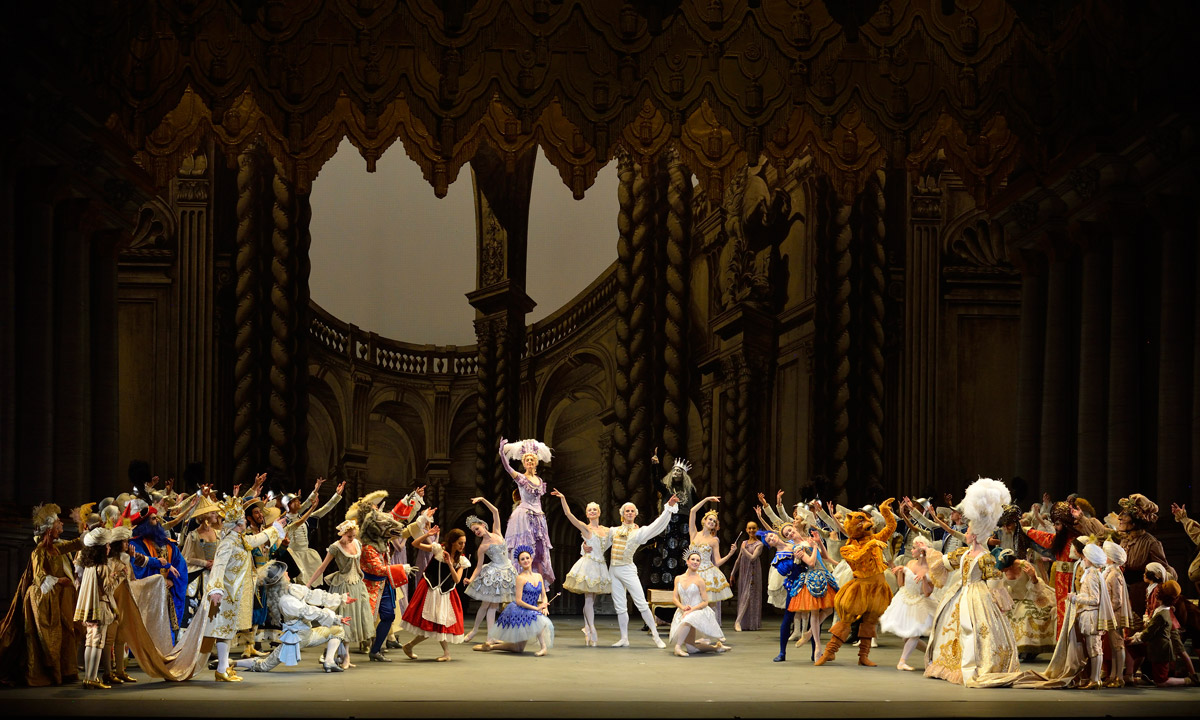
© Gene Schiavone. (Click image for larger version)
The Grand Pas de Deux becomes a romantic duet, rather than the formal celebration of an arranged marriage between the heirs to two kingdoms. When the couple come together after circling the stage, instead of a kiss bestowed by Aurora in arabesque to the kneeling prince, she simply lays her head on his chest. The anachronistic fish dives are a further display of trust, less flashy because her preceding pirouettes are lower. When she bends backwards in his arms, she’s amorous, sensual. Her solo variation tells the prince, and us, about herself: her arms, as she steps forward repeatedly, explain how she grew up from child to bride. Beguiling though the pas de deux may be, its intimacy doesn’t accord with Tchaikovsky’s triumphant music. He and Petipa were celebrating a dynastic marriage, flattering the Romanov rulers of Imperial Russia.
That’s the difficulty with this production. The dancing style looks closer to Bournonville than the Petipa classicism to which we’ve become habituated. When Sergei Vikahrev reconstructed the Maryinsky Ballet’s production of The Sleeping Beauty (seen in London in 2000), using the Stepanov notation, the dancers barely adapted their classical technique, intent on displaying their Vaganova-trained skills. Nonetheless, many Russians so disliked the four-hour-long production that it was dropped and has yet to be revived.
Ratmansky’s account for ABT delves further into fundamentals of style but misses out on the grandeur Vikahrev provided. This Sleeping Beauty is a fairy tale ballet akin to one of Bournonville’s, not a declaration of the power of light over darkness, of the assurance of monarchical continuity. Tchaikovsky’s score reflected and amplified Petipa’s ambitions for his Imperial ballet. Although the reconstructed choreography may be truer to the tempi and phrasing of the music than later accretions, the quality of ABT’s dancing doesn’t match the glorious scale Tchaikovsky achieved.












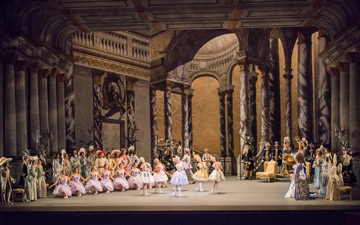
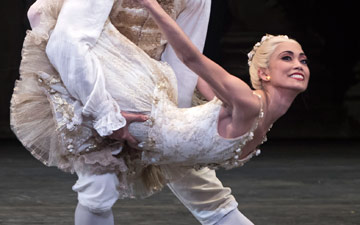
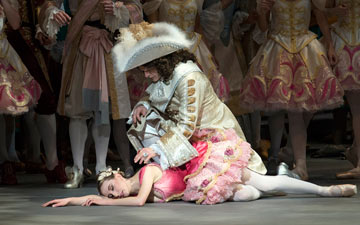
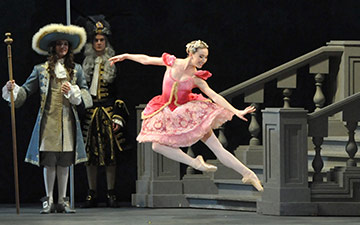
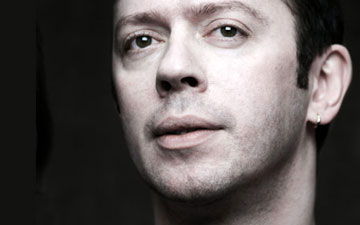
You must be logged in to post a comment.